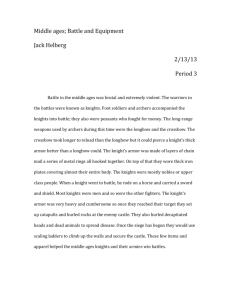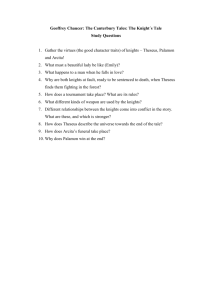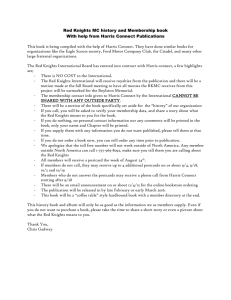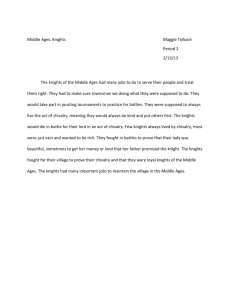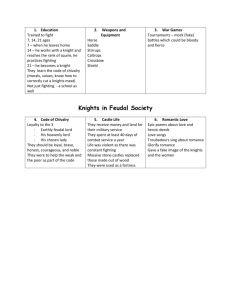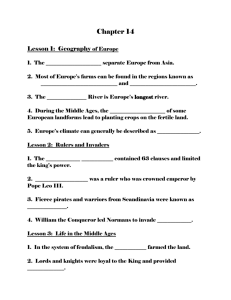Writing a Successful History Essay
advertisement
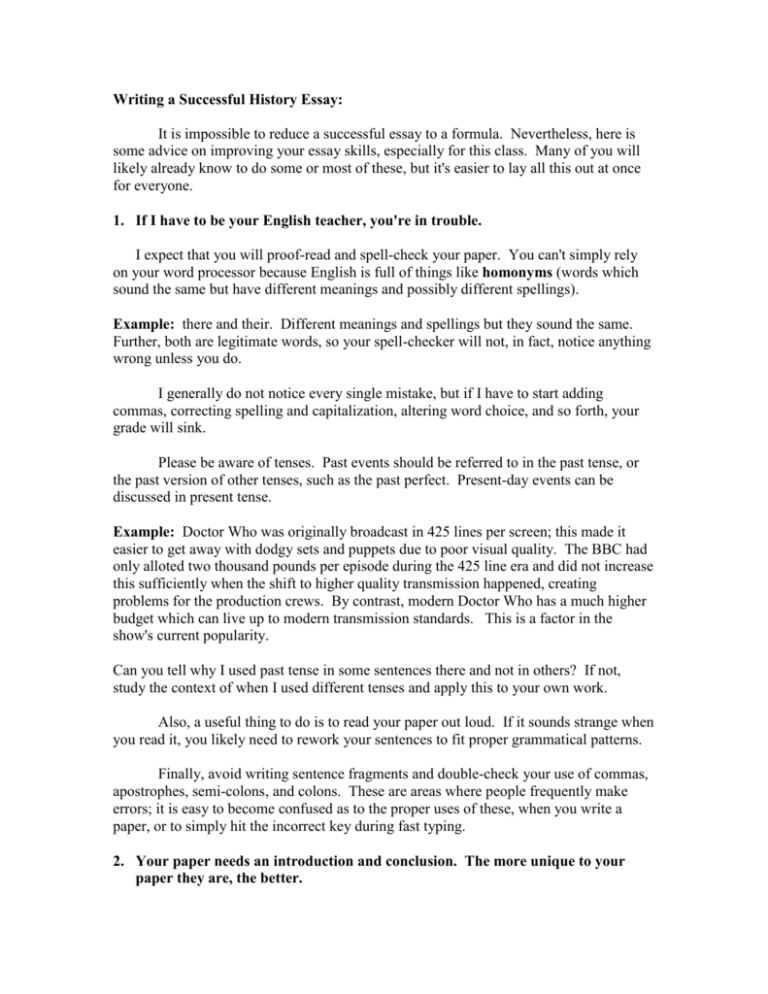
Writing a Successful History Essay: It is impossible to reduce a successful essay to a formula. Nevertheless, here is some advice on improving your essay skills, especially for this class. Many of you will likely already know to do some or most of these, but it's easier to lay all this out at once for everyone. 1. If I have to be your English teacher, you're in trouble. I expect that you will proof-read and spell-check your paper. You can't simply rely on your word processor because English is full of things like homonyms (words which sound the same but have different meanings and possibly different spellings). Example: there and their. Different meanings and spellings but they sound the same. Further, both are legitimate words, so your spell-checker will not, in fact, notice anything wrong unless you do. I generally do not notice every single mistake, but if I have to start adding commas, correcting spelling and capitalization, altering word choice, and so forth, your grade will sink. Please be aware of tenses. Past events should be referred to in the past tense, or the past version of other tenses, such as the past perfect. Present-day events can be discussed in present tense. Example: Doctor Who was originally broadcast in 425 lines per screen; this made it easier to get away with dodgy sets and puppets due to poor visual quality. The BBC had only alloted two thousand pounds per episode during the 425 line era and did not increase this sufficiently when the shift to higher quality transmission happened, creating problems for the production crews. By contrast, modern Doctor Who has a much higher budget which can live up to modern transmission standards. This is a factor in the show's current popularity. Can you tell why I used past tense in some sentences there and not in others? If not, study the context of when I used different tenses and apply this to your own work. Also, a useful thing to do is to read your paper out loud. If it sounds strange when you read it, you likely need to rework your sentences to fit proper grammatical patterns. Finally, avoid writing sentence fragments and double-check your use of commas, apostrophes, semi-colons, and colons. These are areas where people frequently make errors; it is easy to become confused as to the proper uses of these, when you write a paper, or to simply hit the incorrect key during fast typing. 2. Your paper needs an introduction and conclusion. The more unique to your paper they are, the better. Your paper should have an introduction and a conclusion. The introduction should introduce your topic and lay out your basic argument. The conclusion should sum up your argument and lay out your final conclusion, ending your paper. Both should be written so that they cannot be simply snipped off your paper and put on someone else's without someone noticing; in other words, don't be generic and vague. Conversely, though, you don't have to spell out every detail. I just need the big picture. Hitting that sweet spot between too long an introduction and too short takes practice. Your introduction and conclusion should answer the questions posed for the essay without simply restating them. Example Introduction (Bad): Doctor Who is a show on British Television. Lots of people like it, so this paper is about why they enjoy the show. People liked it because it reflected British culture over the course of its run. It was eventually shut down because Michael Grade is the Devil incarnate. Example Introduction (Good): Airing from 1963 to 1989, the first run of Doctor Who entertained several generations of British youth and adults until its eventual cancellation. Its popularity constantly fluctuated, but the show periodically re-invented itself in order to adjust to new technical conditions, changes in society, and changes in how television programming was produced and sold and merchandised in Britain. In the end, however, a combination of mistakes by the final production crews, inability to adept to changes in programming, and the hostility of Michael Grade to the show ended its first run. If your introduction to a paper of ten pages or less takes up more than half the first page, you may be using too much space on it; the same applies to your conclusion. 3. In historical writing, you need to support general arguments with specific evidence. Your historical essays should utilize specific facts in order to support your general assertions. Being able to provide two or three specific incidents to illustrate each general point will strengthen your paper tremendously. You need to not just list the specific incidents or facts, but show how they connect into your overarching argument. Example: Season 7 of Doctor Who begins with the 4 episode serial Spearhead From Space, whose production code was AAA1. Miles and Wood argued that this represented the greatest shift in the entire history of the Series in a variety of ways. Michael Hickerson stated that the biggest shift was the move to color; he argued that it felt like a Troughton story which had been colorized.2 Where Hickerson doesn’t see this as all that important, Miles and 1 Lawrence Miles and Tat Wood, About Time: The Unauthorized Guide to Doctor Who: 1970-1974: Seasons 7 to 11, (New Orleans: Mad Norwegian Press, 2004), p. 6. 2 Michael Hickerson, “Starting Over Again” in http://www.pagefillers.com/dwrg/spea.htm Wood had argued the shift from black and white to color was itself symbolic of a huge revamping of the series. In their essay, “Did Dr. Who end in 1969”, in volume 2 of About Time, they argued the shift from black and white to color changed what viewers would accept and also changed what actually looked good or bad on television.3 Tom May argued in his review that “the adventure has the feel of a film; which is a distinct novelty for the show.”4 This is the result of switching from filming largely on videotape to filming on actual movie film. However, Hickerson complained that “there are a lot of moments that where the dialogue is difficult to hear and the sound quality has an echo to it.”5 Miles and Wood explained this problem, saying that “the film work and consequent flaws in sound recording were forced on the production team by the sceneshifter’s union.”6 If you examine these paragraphs, you'll notice that each detail ties into the overall question being addressed, of how Dr. Who changed as a show with the release of the serial Spearhead From Space. The specifics are fitted into the argument to support it, not just listed after a general argument. Show how your details tie into your general argument. This leads into our next topic. 4. Analysis is the next step up. To improve the quality of your historical writing, you have to improve the quality of your historical analysis. There is no magical formula for this, but to make the jump from what is adequate to what is exceptional, and thus gets a better grade, I have some advice. 4A. Remember chronological order. Events happen in order; this is why we ask you to learn dates. When you write, make sure you know the order of events, and the dates of events; this will enable you to create coherent chains of cause and effect. A common problem is jumbling events together and getting them in the wrong order because you don't know when they happened. Jumping back and forward in time is acceptable as long as you clearly demonstrate you know how events connect to each other; when using several details in support of a single point within a paragraph, though, you should be careful that you understand the chronology of events. 4B. Find Connections. 3 Lawrence Miles and Tat Wood, About Time: The Unauthorized Guide to Doctor Who: 1966-1969: Seasons 4 to 6, (New Orleans: Mad Norwegian Press, 2006), pp. 271-9. 4 Tom May, “More than the sum of its parts” in http://www.pagefillers.com/dwrg/spea.htm 5 Michael Hickerson, “Starting Over Again” in http://www.pagefillers.com/dwrg/spea.htm 6 Lawrence Miles and Tat Wood, About Time: The Unauthorized Guide to Doctor Who: 1970-1974: Seasons 7 to 11, (New Orleans: Mad Norwegian Press, 2004), p. 12. 4A is the precondition for 4B. If you don't know when things happened, then you may find it hard to find the connections. A strong historical paper draws the connections between events instead of just listing them as examples. By tying events together and showing cause and effect relationships, you produce a stronger paper. Show how things connect and what explains the connection. Example (Bad): During the Hundred Years' War, the French were repeatedly defeated by the English even though they had more troops. They lost the Battle of Poitiers in 1356 AD. They were defeated at the Battle of Crecy in 1346 AD. They lost the Battle of of Agincourt in 1415 AD, even though they had 36,000 men to the 9,000 men of the English! They must have really not been trying very hard, given all their victories during the 1200s, like the Battle of Bouvines in 1215 AD, or how they crushed King John and drove him out of Normandy during that century. They only got their act together when Joan of Arc showed up. Example (Good): During the thirteenth century, the Kings of France were growing in power and feudal armies of knights dominated the battlefield. As more of France fell into the hands of the King, he could field ever more knights. This created a kind of 'virtuous circle', where success fed success. King John had fewer knights than Philip Augustus did in the 1200s and 1210s; the result was a defeat due to numerical superiority. This let Philip Augustus conquer Normandy; this gave John less knights and Philip even more of an advantage. Eventually, John, who also had fiscal problems and the hatred of his vassals weighing him down, was driven from France. This forced his descendants to conquer in the British Isles instead of in France. This led Edward I, grandson of King John, to attack the Welsh, who caused heavy losses to the English due to their use of the longbow. The English now deliberately mastered the longbow, which could pierce the armor of knights. Under Edward I's grandson, Edward III, they now invaded France, having transformed their military with new strategies and weaponry, many of them learned from fighting the Welsh. The use of spikes to prevent knights from charging, the use of their own knights as heavy infantry to guard their archers, and the power of the longbow enabled the defeat of numerically superior French armies by the English in the fourteenth and early fifteenth century. Superior generalship exploited terrain, such as the thick forests flanking the battlefield at Crecy and Agincourt, or the vinyards at Poitiers which prevented effective charges by knights. The end result was that until the rise of Joan of Arc, the French kept losing because they were trying to fight with old tactics which had been rendered futile by technological and strategic advances. Studying this, you can see how to link facts together to form larger pictures and how cause and effect links specific events. The successes of the French in the thirteenth century with knights caused them to cling too long to the use of knights in the fourteenth and fifteenth century. Meanwhile, the English learned from fighting the Welsh how well the longbow could change the face of war. They then applied this lesson to beat up the French for decades, until Joan of Arc copied the English tactics. Now, a lot more could be added to this analysis. You may have noticed that it doesn't explain why the French kept ramming their heads into the same wall for eighty years (1346 to 1415), for example.7 There will always come a point where space limitations require you to trim down as well as build up. Notice that I didn't use most of the dates listed in the bad example in the good example. But, the good example was written with awareness of those dates, in order to put events in the right order, so that cause would come before effect, and not after it. So be careful not to bloat your analysis of individual points to the point where it means you lack enough space to handle other important points that need to be addressed. 4C. Structuring with Cause and Effect When you first start out writing papers, most people begin by making a list of their major points, then dedicate a paragraph to each major point, sticking an introduction on the front and a conclusion on the end. This is fine for a high school paper, but higher standards are expected at college, especially in upper level classes. Tying your points together into a logical argument takes your paper to the next level. Ideally, each paragraph of your paper should logically flow into the next paragraph. In History, this can often be done by showing cause and effect linkages. Go back to the good example in the previous section. If you examine it, you will see how each paragraph links logically to the next. The French invention of knights means King John's descendents must conquer in the British Isles, not in France. This leads them to fight the Welsh and improve their armies. Then their improved armies slap the French around with ease for decades, while the complacent French have not changed their ways. Your paper should not read like a list, it needs to be an argument, in which each piece leads logically to the next. If you can do that, you are ready to advance to the next step. 5. Deeper Analysis and Synthesis (Advanced Techniques) I will touch on this only briefly, because we are only using a few sources in this class.8 The next level of historical analysis involves becoming aware of the biases, viewpoints, and limitations of the sources you are drawing your material from. Every source has biases; a major problem for historians is figuring out those viewpoints and 7 The answer is that France was dominated by an elite made up of knights, and moving away from knights would have made them obsolete. Understandably, they were reluctant to get rid of the military role which justified their wealth and power, especially as it would have made it easier for the king to then take that wealth and power himself. A fuller explanation would take too much space for this footnote, however. 8 Entire books have been written simply on this issue. comparing different sources to try to get at the truth. This requires both analysis (where you take arguments apart to see how they tick) and synthesis (where you put the pieces back together in a new form that you at least hope is the truth). Deeper analysis requires finding the ways in which your sources are arguing things themselves. Every history book, every primary source, every paper, has a viewpoint. Understand that viewpoint and you can then compare it to other sources' viewpoints to try to overcome their biases. One of my favorite Dr. Who books is the About Time series, an in-depth analysis of the seasons of Dr. Who from 1963 to 1989. But the authors have several biases I have become aware of, such as their frothing hatred of Star Trek. If they talk about Star Trek, I know I am going to have to compare their ideas to other sources to synthesize a hopefully more objective view of that particular issue. This requires me to understand their arguments and biases, taking them apart to see how their Star Trek hate sometimes warps their judgement. Once you understand how these biases and viewpoints shape the historical accounts and sources you are working with, then you can try to put together the truth behind it; this is known as synthesis. You can see my efforts to put together strands of different author's thought, comparing and contrasting to try to find the deeper truth, in the two paragraph Dr. Who example earlier in this guide. Look at the second paragraph; see how Hickerson has a complaint about the episode, but by consulting Miles and Wood, an answer to that problem was found which explained Hickerson's discontent with more than just aesthetics. This is synthesis. I trust Miles and Wood on issues like explaining behind the scenes components of the production process because I have verified some of their claims with other sources. Conversely, I don't trust them on Star Trek, which I don't think they really understand, so I would have to compare them to someone else on issues of Dr. Who vs. Star Trek. As I noted earlier, this is an advanced technique; in upper-level and graduate courses, the ability to do deeper analysis, source analysis, and further synthesis becomes crucial. I don't generally expect it in an introductory course, but if you can do it, it will strengthen your paper. That being said, the deeper you analyze, the better your grade, and to get a perfect grade, I need to see some deeper insights into the material. What that deeper insight consists of varies topic to topic, but I hope this will help you to achieve better analysis and synthesis in your work. Good luck!


